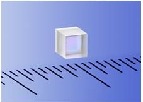Kyocera launches etalon filter with zero temperature characteristics of crystal components
 Kyocera Crystal Components Co., Ltd., a wholly-owned subsidiary of Kyocera Corporation (hereinafter referred to as "Kyocera"), has successfully developed a crystal element manufactured using an atomic diffusion bonding method. "The zero-temperature characteristics of the etalon filter "The device" is currently the first in the industry.
Kyocera Crystal Components Co., Ltd., a wholly-owned subsidiary of Kyocera Corporation (hereinafter referred to as "Kyocera"), has successfully developed a crystal element manufactured using an atomic diffusion bonding method. "The zero-temperature characteristics of the etalon filter "The device" is currently the first in the industry. The etalon filter is a device that senses a plurality of different wavelength deviations of light in an optical communication high-capacity transmission system. In this development, the zero temperature characteristics, high accuracy, high reliability, and miniaturization of the etalon filter were successfully achieved by using the atomic diffusion bonding method for the first time in the industry. This product will be available from January next year and will be sold by Kyocera.
Product Features 1. With the industry's highest level of temperature characteristics, the product's zero temperature performance achieves the industry's highest temperature performance of ±0.15pm/°C. This is achieved through the use of atomic diffusion bonding and design techniques that combine positive temperature characteristics with crystals of negative temperature characteristics and advanced crystal processing techniques.
The zero-temperature etalon filter eliminates the need for a Peltier thermal element for temperature regulation, helping to achieve miniaturization of the variable wavelength laser module and achieving a good energy saving effect.
2. The first atomic diffusion bonding method for crystal elements using the atomic diffusion bonding method in the industry is a direct bonding technique developed by Professor Toshiaki Takeshi, Tohoku University in Japan. It is an adhesive that does not use organic type, and is not heated, pressurized, or Technology for bonding wafers and substrates under voltage conditions. Kyocera's Crystal Element Co., Ltd., through joint development with a professor Shimadzu's research group, applied the atomic diffusion bonding method to a crystal element for the first time in the industry, successfully bonding crystal wafers with high-strength metal films from several atomic layers to several tens of nanometers in thickness. . This solves the problems associated with the bonding methods such as the photo-bonding bonding method with weak bonding strength in the past and the organic adhesive bonding method with difficulty in controlling the thickness, and realizes high accuracy, high reliability, and miniaturization of the etalon filter. .
â– Development Background The core oscillating element that converts electrical signals into optical signals is a necessary part of the optical communication's high-capacity transmission system, and the etalon filter is a kind of monitor used to monitor it. Whether the wavelength of light is stable oscillation component.
In recent years, with the rapid spread of the Internet and the large increase in the volume of video and other large-capacity data, large-capacity and high-speed transmission have become the subject of optical fiber communication, and more optical signals (information volume) can be transmitted using one optical fiber. ※4 Transmission systems have gradually become mainstream. However, since the variable wavelength module of the WDM transmission system needs to install multiple units from a medium-distance to a near-distance transmission device, a product with a smaller profile and more energy saving is required.
This product achieves miniaturization while also having zero temperature characteristics, high accuracy, high reliability, and being less susceptible to external temperature effects. Therefore, it is no longer necessary to use a temperature-controlling Peltier thermal element or the like, which contributes to the miniaturization and power reduction of the variable wavelength laser module.
Kyocera's crystal element company has a one-stop production system from the cultivation of crystal materials to the design, processing, coating, and property evaluation. In the future, it will continue to strengthen the component supply capabilities in the field of optical communication related to high-speed high-capacity optical communication technology. Development contributes.
WDM (Wavelength Division Multiplexing). The abbreviation of wavelength division multiplexing system is a communication technology using optical fiber.
â– Product features (for reference)
1. The highest level of temperature characteristics in the industry is compared to our previous product (Crystal E.C. Filter N type). The temperature of this product has been significantly reduced from the original 5.4 pm/°C to ±0.15 pm/°C.
2. The advanced crystal processing technology achieves a stable and reliable joint effect through the unique plane processing technology and advanced cleaning technology accumulated by KYOCERA Crystal Components in over 50 years of development.
LED Architectural Lighting are decorative, contemporary lighting fixtures for architectural projects,it combine architectural form and versatility to make an excellent choice for new construction or retrofit applications.
Our Architectural Lighting have including: Led Wall Washer ,Led Flood Light, led linear washer,Led Linear Light, Led Wall Light ,led strip light,etc.. Products are developed and designed to hug and highlight architectural shapes perfectly and formed to fit a wide variety of projects.And at the same time offering enormous savings in energy use.With high efficiency,long life LED,multiple color function, our architectural lighting will deliver exceptional performance for the illumination and decoration of the building structures.
Led Architectural Lighting,Architectural Lighting,Architectural Area Lighting,Commercial Exterior Lighting
Guangdong guangzhidian lighting Co., Ltd. , https://www.gzdlighting.com